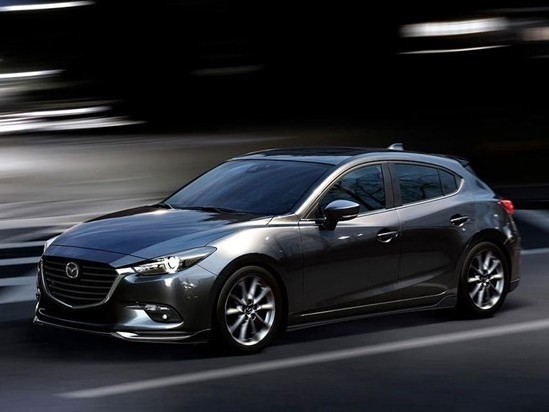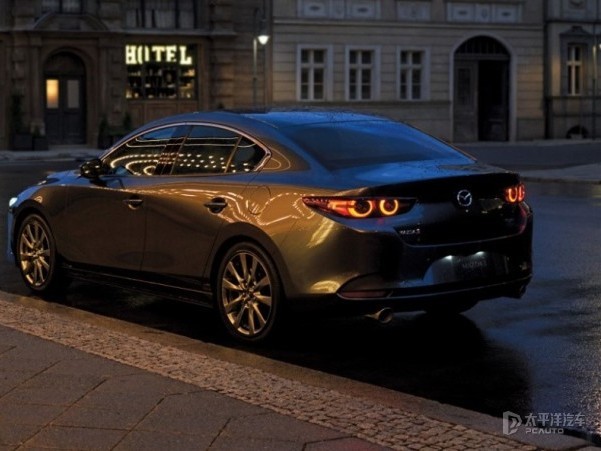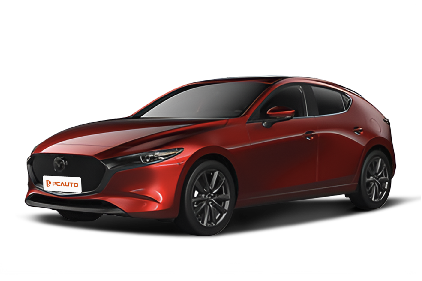Q
How many liters of fuel does the Mazda3 Hatchback need for 100 kilometers?
The official combined fuel consumption for different versions of the Mazda3 hatchback varies. For the 1.5-liter model, the official figure is 5.9L/100km, while the 2.0-liter model has an official consumption rate of 6.3L/100km. However, these are just official data, and actual fuel consumption can be influenced by various factors such as driving habits, road conditions, and vehicle load. For instance, frequent rapid acceleration and hard braking, or driving in congested traffic, can lead to increased fuel consumption. In contrast, maintaining a smooth driving style, effectively planning routes to avoid congestion, and regularly servicing the vehicle, including ensuring proper tire pressure, can help reduce actual fuel consumption.
Special Disclaimer: This content is published by users and does not represent the views or position of PCauto.
Related Q&A
Q
What Segment is Mazda 3 Hatchback?
The Mazda 3 Hatchback falls into the C-Segment (also known as compact cars segment) in the Malaysian market, sharing the same class as models like the Honda Civic and Toyota Corolla. This five - door hatchback is popular among young consumers for its dynamic design, refined interior, and excellent handling performance. The Skyactiv - technology engine it's equipped with strikes a balance between fuel efficiency and power output, making it suitable for both city driving and long - distance trips.
In Malaysia, C - Segment models are well - received for their combination of practicality and driving pleasure. The Mazda 3 Hatchback further enhances its competitiveness by offering a wide range of features such as a head - up display and a Bose audio system.
It's worth noting that when Malaysian consumers are making a purchase, they can compare the after - sales warranty policies and spare - parts availability of competing models in the same segment. At the same time, they should also consider their own needs regarding body size and trunk space. Although the hatchback design is stylish, its cargo - carrying capacity is slightly inferior to that of the sedan version. If you often need to carry a large amount of cargo, you may need to weigh the pros and cons.
Q
What is the Reslae Value of Mazda 3 Hatchback?
The Mazda 3 Hatchback has shown stable resale value in the Malaysian used - car market. This is mainly due to its outstanding design, reliable powertrain, and the brand's good reputation. Generally, a three - year - old used Mazda 3 Hatchback can retain 60% to 70% of its original price, depending on the vehicle's age, mileage, and maintenance condition. If the car has been well - maintained and has low mileage, its residual value could be even higher.
Mazda's Skyactiv technology has improved fuel efficiency and the driving experience, further enhancing its market competitiveness. Regular maintenance at authorized service centers and keeping complete records can also significantly increase the used - car value. Moreover, Malaysian consumers prefer Japanese cars for their high durability and low maintenance costs, which makes the Mazda 3 Hatchback quite popular in the used - car market.
For potential buyers, it is recommended to check the vehicle's accident history and repair records. At the same time, compare it with competing models of the same year, such as the Honda Civic or the Toyota Corolla Hatchback, to make a more comprehensive decision.
Q
How Many CC is Mazda 3 Hatchback?
The Mazda 3 Hatchback offers engine options in the Malaysian market, mainly including the 1.5-liter and 2.0-liter Skyactiv-G gasoline engines with displacements of 1496cc and 1998cc respectively. Both of these engines adopt Mazda's advanced Skyactiv technology, which focuses on balancing fuel efficiency and power output. The 1.5-liter version is suitable for daily commuting, while the 2.0-liter version can provide stronger power performance.
For Malaysian consumers, it's important to choose the right engine displacement according to their needs. Displacement not only affects power performance but also road tax and fuel economy. In Malaysia, road tax is calculated based on engine displacement; the larger the displacement, the higher the road tax. Thanks to the optimization of Skyactiv technology, these two engines can achieve good power output while also taking fuel economy into account.
The Mazda 3 Hatchback is very popular among young consumers for its excellent handling and Kodo design language. It's a popular hatchback model in the Malaysian market that combines sportiness and practicality, and it can handle both city driving and occasional long - distance trips.
Q
What is the Engine in Mazda 3 Hatchback?
The Mazda 3 Hatchback mainly offers two high - performance Skyactiv - G gasoline engine options in the Malaysian market, namely the 1.5 - liter and 2.0 - liter four - cylinder naturally aspirated engines. The 1.5 - liter version has a maximum output power of 114 horsepower, which is suitable for daily commuting and has excellent fuel economy. The 2.0 - liter version provides 156 horsepower, with more abundant power. It is also equipped with Mazda's unique Skyactiv - Vehicle Dynamics vehicle dynamic management system, offering more precise handling performance.
Both of these two engines adopt a high - compression ratio design (13:1). Combined with direct - injection technology and a 4 - 2 - 1 exhaust system, they effectively improve combustion efficiency and reduce fuel consumption, while meeting the Euro 5 emission standards in Malaysia. It's worth noting that Mazda's Skyactiv technology optimizes internal engine friction and uses lightweight design. While maintaining the linear power output of the naturally aspirated engine, it also takes environmental protection performance into account, making it suitable for Malaysia's diverse road conditions.
If you have higher performance requirements, you can pay attention to the Skyactiv - X compression - ignition engine version available in overseas markets. Its thermal efficiency is further improved through the SPCCI spark - controlled compression ignition technology. However, this version has not been introduced to Malaysia yet. It is recommended that car owners regularly use the 0W - 20 low - viscosity engine oil recommended by the original factory and 95 - octane or higher gasoline to fully unleash the engine's performance.
Q
What is the Gearbox Type of Mazda 3 Hatchback?
The Mazda 3 Hatchback offers two main types of transmissions in the Malaysian market, namely the 6-speed automatic manual integrated transmission (Skyactiv-Drive) and the 6-speed manual transmission. The specific configuration depends on the model version and the year. Among them, the Skyactiv-Drive automatic transmission is well - known for its smooth shifting experience and fuel economy. It adopts Mazda's exclusive Skyactiv technology, which enhances the driving experience by optimizing transmission efficiency and reducing power loss. The manual transmission version is more suitable for drivers who pursue the joy of control, providing more direct shifting feedback. It's worth mentioning that Mazda's Skyactiv technology not only focuses on performance but also takes environmental protection needs into account, which meets the preference of the Malaysian market for energy - efficient models. If you have further questions about the transmission configuration of specific models, it is recommended to check the official website of Mazda Malaysia or consult local dealers to get the latest information. At the same time, you can also take a test drive to experience the actual performance of different transmissions so as to choose the version that best suits your driving habits.
Q
What is the PCD Size of Mazda 3 Hatchback?
The PCD (Pitch Circle Diameter) of the Mazda 3 Hatchback is 5x114.3. This means there are 5 bolt holes on the wheel hub, and the centers of these holes are distributed on a circle with a diameter of 114.3 millimeters. This specification is quite common in the Malaysian market and is shared by many Japanese - made models such as the Honda Civic and Toyota Corolla, which makes it convenient for car owners to replace or upgrade their wheels. Understanding the PCD size is crucial when replacing wheels or installing new tires, as an incorrect PCD will prevent the wheels from being installed properly, which can affect driving safety.
Apart from the PCD, when choosing wheels, car owners also need to pay attention to the center bore diameter (CB) and the offset value (ET) to ensure a perfect match with the vehicle. In Malaysia, many wheel modification shops are familiar with these parameters. It's recommended that car owners consult professionals or refer to the vehicle manual before modification to ensure compatibility.
The Mazda 3 Hatchback is well - known for its handling and design. A reasonable wheel upgrade can further enhance its appearance and performance. However, it's essential to choose high - quality products that meet the specifications to ensure safety.
Q
Does Mazda 3 Hatchback Have Apple Carplay?
Yes, the Mazda 3 Hatchback in the Malaysian market is indeed equipped with Apple CarPlay. This feature has become standard in recent models, allowing iPhone users to seamlessly connect their phones to the car's display and use apps like navigation, music, and calls. The entertainment system of the Mazda 3 Hatchback also supports Android Auto, meeting the needs of users with different types of phones. Its user interface is clean and smooth, integrating well with the Mazda Connect system, which enhances both convenience and safety while driving. In addition to Apple CarPlay, the vehicle also comes with several practical technologies, such as a Head-Up Display (HUD) and a Bose sound system, further enhancing the driving experience. For Malaysian consumers, the Mazda 3 Hatchback is not only known for its stylish design and handling performance, but its rich technological features also make it a popular choice among cars in the same class. If you value smart connectivity features, this car is worth considering.
Q
What is the Tyre Brand of Mazda 3 Hatchback?
The original - equipped tire brands of the Mazda 3 Hatchback in the Malaysian market may vary depending on the model year and configuration. Common combinations include international brands such as Bridgestone, Dunlop, or Toyo. Specific models, like the Bridgestone Turanza T005A or Dunlop Enasave EC300+, focus on quiet comfort and wet - surface performance, meeting the needs of the local rainy climate. Car owners can confirm the original specifications through the sidewall markings of the tires or the vehicle manual. It is recommended to choose tires that match the original size (e.g., 215/45 R18) and load index to ensure safety.
If replacement is needed, similar products such as the Michelin Primacy 4 or Goodyear EfficientGrip can be considered. They also emphasize low rolling resistance and durability. However, it should be noted that the dry and wet - surface performance and wear - resistance index of tires from different brands may affect the driving experience.
In Malaysia, where it is hot and rainy, regularly checking the tire pressure and tread depth (it is recommended to be no less than 1.6 millimeters) can extend the tire life and improve fuel economy. Pay more attention to the drainage performance before the rainy season to prevent skidding.
Q
Is Mazda 3 Hatchback a Good Car? Learn the Pros and Cons Here
The Mazda 3 Hatchback is a compact hatchback that's quite popular in the Malaysian market. Its advantages include a stylish and dynamic exterior design, delicate interior craftsmanship, and excellent handling performance. The Skyactiv - technology engine it's equipped with strikes a good balance between fuel economy and power output. Meanwhile, the standard i - Activsense safety system offers leading active and passive safety features in its class.
However, the rear - seat space is relatively cramped, and the maintenance and repair costs are slightly higher than some Japanese competitors. The sporty suspension tuning might not meet the comfort needs of some consumers. For Malaysian consumers, this car is especially suitable for young people who pursue driving pleasure. Its Kodo design language also enjoys high popularity in the local car modification circle.
It's worth noting that in tropical climates, it's advisable to choose ventilated seats and regularly check the air - conditioning system. At the same time, the 5 - year warranty policy provided by the manufacturer can effectively reduce the cost of car ownership. Among models in the same class, you can also refer to the Toyota Corolla Hatchback or the Honda Civic Hatchback for a horizontal comparison. It's recommended to take a test drive and then make a choice according to your personal needs.
Q
What is the Width of Mazda 3 Hatchback?
According to official data, the body width of the Mazda 3 Hatchback is 1,795 millimeters. This dimension puts it in the upper - middle range among compact hatchbacks in the Malaysian market. It offers both a comfortable seating space and great maneuverability for city driving. For Malaysian consumers, this width ensures that they don't feel cramped when driving on narrow streets or in parking lots, while also guaranteeing sufficient lateral space for passengers inside the car.
The Mazda 3 Hatchback features the brand's unique Kodo design language. The smooth body lines not only enhance the car's visual dynamism but also optimize its aerodynamic performance. In Malaysia's tropical climate, the car's air - conditioning system can effectively cool the entire cabin, ensuring a comfortable driving and riding experience.
Notably, the handling performance of the Mazda 3 Hatchback has also received wide acclaim. Its precise steering and stable cornering performance are well - suited to Malaysia's winding roads. Additionally, this car is equipped with a wealth of safety features, such as blind - spot monitoring and lane - keeping assist systems, which provide extra protective support for Malaysian drivers.
Latest Q&A
Q
Does the 2020 Honda Accord have transmission problems?
The 2020 Honda Accord has performed well overall in the Malaysian market. Its CVT and 10-speed automatic transmissions (depending on the trim) are technically mature, with most owners reporting smooth and reliable operation. However, some isolated cases may experience slight low-speed hesitation or delayed shifting, which are common characteristics of CVT transmissions rather than malfunctions. Honda Malaysia has not issued any large scale recalls or technical bulletins for this model regarding the transmission. It is recommended to check the transmission fluid condition during regular maintenance to ensure optimal performance. For consumers considering a used 2020 Accord, it is advisable to conduct a pre-purchase inspection through an authorized Honda service center, focusing on reading transmission fault codes and historical data. Notably, while CVT transmissions are known for their fuel efficiency, driving style can affect their lifespan. It is recommended to avoid frequent hard acceleration to extend component longevity. If unusual shifting vibrations or warning lights appear, contact an authorized Honda service point promptly for professional diagnosis. All Honda service centers in Malaysia are equipped with dedicated diagnostic equipment to quickly identify issues.
Q
What year to avoid Accord?
In Malaysia, the Honda Accord is a popular mid-size sedan, but certain model years can have some common issues that buyers should watch out for when shopping around. Based on owner feedback and expert reviews, some 2013 and 2014 Accord models had problems with transmission jerking and electronic system glitches, especially the CVT-equipped versions, which might develop rough shifting after long-term use. Additionally, owners of 2008 to 2010 Accords have reported higher fuel consumption and suspension noises. While these don't affect driving safety, they could increase long-term maintenance costs. If you're buying a used Accord, it's better to prioritize models from 2015 onwards—they saw significant improvements in reliability and fuel efficiency. Malaysia's hot and humid climate means you should also pay extra attention to the car's air conditioning system and electrical wiring when checking it out. Regular maintenance can really help extend the vehicle's lifespan. If your budget allows, the new Accord's hybrid system performs better in terms of fuel savings and driving experience, making it a good fit for buyers who value eco-friendliness and comfort.
Q
Which is better, the 2019 or the 2020 Honda Accord?
Both the 2019 and 2020 Honda Accord are really popular mid-size sedans in the Malaysian market. They don't differ much in core specs, but the 2020 model gets some nice detail upgrades. On the outside, the 2020 Accord has subtle tweaks to the front grille and wheel designs, giving it a more modern look, plus there are new exterior color options. Inside, the 2020 version comes standard with an 8-inch infotainment screen and an upgraded Honda Sensing safety suite, including more responsive adaptive cruise control and lane-keeping assist – features that were optional on some 2019 trims. Under the hood, both models offer the 1.5T turbo engine or the 2.0L hybrid system, with similar fuel economy, but the 2020's CVT transmission feels smoother in its tuning. For Malaysian buyers, if your budget allows, the 2020's upgraded features are worth considering, especially the improved safety tech which is really handy for daily driving. It's worth noting that 2019 models might offer better value in the used car market, but make sure to check the service records carefully if you go that route. The Honda Accord is known in Malaysia for its reliability and low maintenance costs, so both model years are solid picks – it just comes down to your budget and how much you want the newer features.
Q
Which year of Accord is most reliable?
In the Malaysian market, the Honda Accord is a favorite among consumers for its reliability and durability, especially the ninth-generation models produced from 2013 to 2017, which deliver an outstanding overall performance. This generation comes with an optimized 2.4-liter naturally aspirated engine or a 3.5-liter V6, offering smooth power delivery and decent fuel efficiency. It's paired with either a CVT or 6-speed automatic transmission—both mature technologies with low failure rates. Additionally, the ninth-gen Accord features a solid body structure and a well-tuned chassis that balances comfort and handling, making it suitable for Malaysia's diverse road conditions. If your budget is tight, the eighth-generation Accord (2008–2012) is also a solid pick, though keep in mind that some high-mileage used units may have issues like worn steering gears or suspension bushings. When shopping for a used Accord, prioritize checking regular maintenance records and pay close attention to the upkeep of critical components like transmission fluid and timing chains. As for hybrid versions, the i-MMD system in the tenth-generation Accord (2018 onwards) performs reliably, but battery life will gradually decline with years of use—professional testing is recommended before purchase. Overall, the Accord ranks among the most reliable in its class, and with proper maintenance, it can stay in great shape for the long haul.
Q
How long will a 2020 Accord last?
The 2020 Honda Accord can typically clock 200,000 to 300,000 kilometers or more with regular maintenance and proper use. Its actual lifespan depends on the owner's driving habits, how often it's serviced, as well as road conditions and climate in Malaysia. Under the hood, it’s packing Honda’s reliable Earth Dreams engine paired with a CVT transmission—proven tech with solid durability. Sticking to regular oil changes, transmission fluid replacements, and maintaining key components like the brakes and suspension can seriously extend its road life. Malaysia’s hot and humid weather might take a toll on rubber parts (think belts and seals) and the battery, so it’s a good idea to check these every six months and opt for original or high-quality replacement parts. Also, the Accord holds its value pretty well in Malaysia’s used car market, and a solid service history can bump up its resale price even more. For long-term ownership, follow the official maintenance manual and head to authorized Honda service centers for upkeep—you’ll get professional technical support and genuine parts that way. If you’re planning to keep it for the long haul, consider periodic deep maintenance too, like fuel system cleaning and coolant replacement, to keep the car in top shape.
View MoreRelated News

Seeing the Ferrari Purosangue reminds one of the Mazda 3 Hatchback
Kevin WongDec 2, 2024

2023 Mazda 3 Hatchback: Six colors, two configurations, is it worth RM160,000?
JohnOct 17, 2024

Mazda 3 Hatchback, priced from RM166,059, how to choose between the two models?
AshleyJul 15, 2024

Rumor: Toyota and Mazda collaborate to develop the next-generation MX-5 and GR86
AshleySep 30, 2025

MAZDA EZ-60 will be launched in China, and will be available in other global markets in 2026
RobertSep 30, 2025
View More


















Pros
Cons